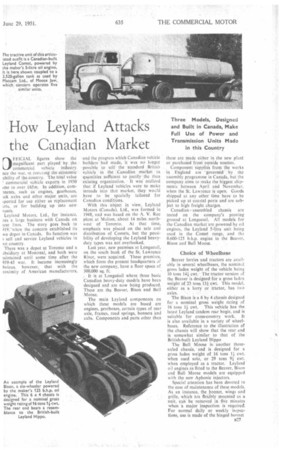How Leyland Attacks the Canadian Market
Page 101

If you've noticed an error in this article please click here to report it so we can fix it.
Three Models, Designed and Built in Canada, Make Full Use of Power and Transmission Units Made in this Country
1 FFICIAL figures show the magnificent part played by the commercial vehicle industry ace the war, in restoring the eekinomic ability of the country. The total value ' commercial vehicle exports in 1950 ime to over £65m. In addition, comments, such as engines, gearboxes, ick axles and other. major . units,-are tported for use either as replacement irts, or for building up into new rassis.
Leyland Motors, Ltd., for instance, aes a laree business with Canada ott line lines. The story goes back to ?19.---when the concern established its wn depot in Canada. Its function was ) sell and service Leyland vehicles in lat country.
There was a depot at Toronto and a ibsidiary at Montreal, and both were iaintained until some time after he 939-45 war. It became increasingly bvious. however, that with the roximity of American manufacturers,
-and the progress which Canadian vehicle buildershad made, it was no longer possible to sell' the standard Britis'a vehicle in the :Canadian market in quantities sufficient to justify the then existing organization. It was realized that if Leyland vehicles were to make inroads into that market, they would have to be specially tailored for Canadian conditions.
With this object in view, Leyland Motors (Canada), Ltd., was formed in 1948, and was based on the A. V. Roe plant at Mahon, about 14 miles northwest of Toronto. At that time, emphasis was placed on the sale and distribution of Cornets, but the possibility of developing the Leyland heavyduty types was not overlooked.
Last year, new premises at Longueuil, on the south bank of the St. Lawrence River, were acquired. These premises, which form the present headquarters of the new company, have a floor space of 300,000 sq. ft. •
It is at Longueuil where three basic Canadian heavy-duty models have been designed and are now being produced. These are the Beaver, Bison and Bull Moose.
The main Leyland components on which these models are based are engines, gearboxes, certain types of rear axle, frames, road springs, bonnets and cabs. Components and parts other than these are made either in. the new plant or purchased from outside sources.
Component supplies from the works in England are governed by the assembly programme in Canada, but the company aims to make the biggest shipments between April and November, when the St. Lawrence is open. Goods shipped at any other time have to be picked up at coastal ports and are subject to high freight charges.
Canadian assembled chassis are tested on the company's proving ground at Longucuil. MI models for the Canadian market are powered by oil engines, the Leyland 5-litre unit being used in the Comet range, and the 0.600-125 b.h.p. engine in the Beaver, Bison and Bull Moose.
Choice of Wheelbase Beaver lorries and tractors are available in several wheelbases, the nominal gross laden weight of the vehicle being 10 tons 141 cwt. The tractor version of the Beaver is designed-for a gross laden weight of 23 tons_ 131 cwt. This model, either as a lorry or tractor, has Iwo
axles.
The Bison is a 6 by 4 chassis designed for a nominal gross weight rating of 16 tons l cwt. This vehicle has the latest Leyland tandem rear bogie, and is suitable for cross-country work. It is also available in a variety of wheelbases. Reference to the illustration of the chassis will show that the rear end is somewhat similar to that of the British-built Leyland Hippo
The Bull Moose is another threeaxled chassis, and is designed for a gross laden weight of 16 tons 1 cwt. when used solo, or 29 tons 91 cwt.. when employed as a tractor. Leyland oil engines as fitted to the Beaver, Bison and Bull Moose models are equipped with the new Aphonic injectors.
Special attention has been devoted to the ease of maintenance of these models. As an instance, the bonnet, wings and grille, which are flexibly mounted as a unit. can be removed in five minutes when a major inspection is required. For normal daily or weekly inspections, use is made of the hinged bonnet












































































































































